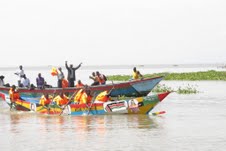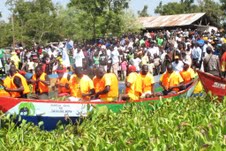Fishermen on a fishing expedition in Lake Victoria’s Kenyan side.


By Dickens Wasonga.
According to maritime experts, an estimated 5000 people drown in Lake Victoria annually as risks of navigating through the lake waters persists. These are people who perish in the lake while either using it for transport or on fishing expedition.
Addressing journalists from Kisumu during a special media briefing organized by the Lake Victoria Basin Commission last week in Kakamega town to give a report on achievements by the commission since 2006 , the LVBC Executive Secretary Dr. Canisius Kanangire said the trend was worrying EAC member countries and revealed that efforts to reverse it were already being enhanced.
The LVBC boss said bad weather, unstable boats, over loading, lack of safety gadgets and poor seamanship amongst others are some of the reasons being attributed by maritime authorities as being behind the increasing cases of accidents within the world’s second largest fresh water lake.
However all is not lost . Lake Victoria Basin Commission which was established 6 years ago by the EAC member’s states to promote and facilitate sustainable utilization of the natural resources within the basin has embarked on the implementation of an ambitious four year strategic plan which amongst other measures will address safety of the lake.
Already the East African Legislative Assembly that draws its membership from the five EAC partner states has enacted Lake Victoria Transport Act which will soon be fully operational zed to help in regulating navigation and shipping laws to be jointly applied by the member states in order to improve safety within lake Victoria.
Amongst a raft of measures, the commission’s four year strategic plan also seeks to establish 16 search and rescue stations around the lake. Out of the 16 stations, 3 will be on the Kenyan side, 8 in Tanzania and 5 in Uganda. The allocation , according to LVBC was pegged on the size of the lake each member country occupies.
The stations will also serve as training centers where people can learn about maritime safety among them the fishermen many of whom have perished in the lake waters in the past. The commission is also in the process of putting in place a maritime telecommunication network which is set to cover the lake surface as well as the entire shoreline.
Towards this end an emergency number 110, which can be used for search and rescue services in Lake Victoria by anyone in distress has also been adopted for use by the national regulatory authorities of each of the EAC states.
According to the LVBC Maritime Communication and Safety on Lake Victoria project coordinator Eng. Vincent Hagono, a pilot emergency response control and positioning center has already been launched and tested in Kampala Uganda in the network that will cover over 80 per cent of the fishing areas of the lake.
Eng. Hagono said phase one of the project that seeks to ensure safety in the lake started three years ago at a cost of 20 million US dollars while its second phase will require additional 10 million US dollars to complete.
LVBC , headquartered in Kisumu Kenya is facilitating and promoting the implementation of a number of key community driven projects executed by various state actors in each member state amongst them, water supply and sanitation projects, protection of water catchment areas, income generating activities which in the end should aid it in its vision of having a prosperous population living in a healthy and a sustainably managed environment .
Currently the commission which receives 90% of its funding from the World Bank is headed by Dr. Canisius Kanangire of Rwanda as its Executive Secretary and has a staff of 60 people drawn from across the EAC partners’ states. It plans to build a state of the art offices in Kisumu where the host country Kenya has donated 2.5 hectares piece of land for the project.
ENDS.
